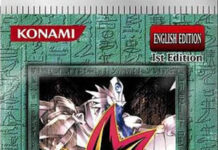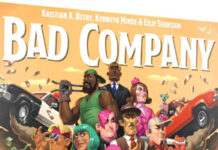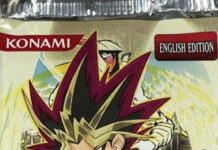This is part of an ongoing series, which I started way back with the original Mystery Booster playtest cards. Check them out!
There used to be a joke on the Wizards of the Coast forums, about blue and black and their portions of the color pie. People said that blue’s portion was “do anything”, and black’s portion was “pay some life: do anything”. This was an exaggeration, even in 2006; but it was less of an exaggeration than you would hope. Remember, back then we were about four to five years removed from Dark Ritual and Necropotence being legal in Extended, and perhaps slightly further from Yawgmoth’s Bargain decks being in Standard. That’s a long time in Magic design, but certainly well within the memories of many players. Even with things being toned down compared to those cards, most black decks of the day revolved around Dark Confidant and/or Phyrexian Arena, and people got busy trying to break Infernal Tutor from the minute Dissension was released. There was definitely an element of truth to the joke.
As far as I can recall and tell from looking back, this seems to have been a problem with definitions and limits. Sacrificing things like life (Necropotence) or cards (Dark Ritual) for something else is a core part of black’s color pie; but what exactly is black allowed to sacrifice? What is it allowed to get in return? What is the relationship between the amount of the resource it sacrifices and the amount of payoff it gets? If blue’s tools are the easiest to accidentally make overpowered, black’s are easily in second place with a large gap to third. I don’t feel like the aforementioned relationships are defined well even now, and this probably has something to do with black’s current design issues.
It feels like every black card revolves somehow around putting something in the graveyard or taking something out of it. It really jumps out when you’re trying to make a cube; you can try to work around it by giving it something like kindred themes, but even a lot of those involve the graveyard on one side or the other. Zombies are probably the worst offender for that, though most of black’s major creature types are guilty of this to one extent or another. There’s even a Mystery Booster 2 playtest card that lampoons black’s current design tropes – Common Black Removal.
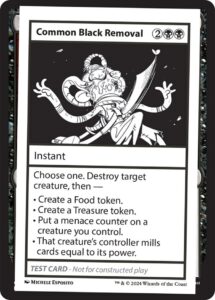
This is a cute card and all, and as a longtime player I enjoy the Time Spiral / Modern Horizons mentality rubbing off on other sets, including the art that references multiple cards (including, amusingly, both Eviscerate and Impale). But if they’re aware of black’s lack of mechanical diversity, they’re the ones who can do something about it. How long is it going to be interesting to chuckle and then go back to wishing they made a more interesting product?
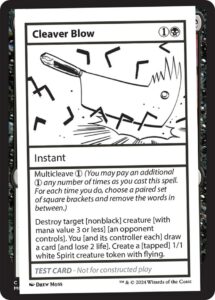
It’s been said that every mechanic is just kicker in a different hat. There is an element of truth to this, if you choose to interpret it that way; regardless, I won’t hold that against the multicleave ability. What I will hold against it is having so many bracketed clauses and so many possible outcomes that if you and your opponent both have stack interaction, you could get so distracted that by the time the card resolves, you won’t remember which options you chose. Then again, it’s not so much wordier than most of the cards in Aetherdrift, so it wouldn’t entirely surprise me if it becomes a mainline ability either.
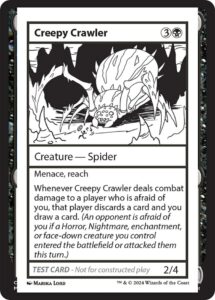
We’ll see more batching of effects and creature types later on in the Mystery Booster 2 playtest cards, and I think there’s a simple reason for that: it’s a comparatively straightforward way to extend and expand certain kinds of effects. It’s another stage in the reaction to the ancient problem of Goblin King not originally being a goblin and Zombie Master not originally being a zombie. We started with errata, and now we’ve moved on into dealing with the more intuitive cases, with varying degrees of effectiveness (I always forget at least one of the “outlaw” creature types).
I quite like it, personally, though it requires judicious use of the space available in rules text boxes. Ironically, they were close to starting this much earlier than they did. There was once an article on Wizards of the Coast’s site, sadly now deleted, which discussed the design process for the 2003 card face update that accompanied the Eighth Edition core set. One option they considered was a design with an expanded typeline, where they could have fit more characteristics than just the ones that we consider usual now. So a card like Radha, Heir to Keld could have had a typeline that included something equivalent to “Legendary Creature – Elf Warrior”, but also other elements from her storyline or lore like “Keldon”, “spark”, or even “female”. I’m not sure whether this would have been more convenient than batching, though it certainly would have meant just one place to look for characteristics like that. It’s interesting to think about either way.
One last thing – given what we now know about Duskmourn, it seems like “afraid of you” must have been a mechanic cut from its development. I’m not sure whether or not to feel that we missed out: it’s a very cool name and a compelling concept, but as written here it adds a lot of complexity due to counting multiple, varied things.
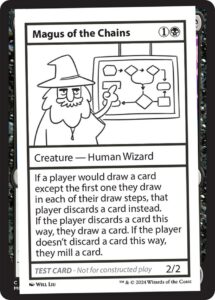
One of the most interesting lessons I’ve learned by playing Magic for so long was realizing that even the basic rules and mechanics lead to a great deal of emergent complexity. Adding intentional complexity on top, as you sometimes see in very large constructed formats or Vintage Cubes, can lead to absolute mental gridlock even in experienced players. I’m dismayed that Wizards of the Coast has been moving back towards that intentional wordy complexity in recent sets, but heartened by the apparent success of the much more elegant Foundations. And I’m perfectly fine with Magus of the Chains staying in the test card / Un-set space. I used to think I knew how Chains of Mephistopheles worked, and later found out I was wrong. That was more than enough of the concept for me.

This is another card you could easily imagine seeing in a Modern Horizons-type set, and I think it captures Belzenlok’s story conceit very effectively. It almost reminds me of the way that some decks in Ravnica: City of Guilds Standard used Mimeofacture to steal a second copy of opponents’ Kamigawa legends from their library, though its uses are a little different. You’ll have to either weather the Saga’s sequence, or force the opponent to discard it first. But there’s a place for that, as there is for a self-mill deck built around Sagas, and this is a fun card for thinking about possibilities.
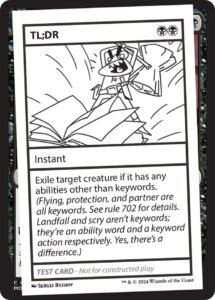
This is my favorite Mystery Booster 2 playtest card, despite it being, yet again, something that could essentially be a real card now. It would probably need that exact reminder text, unfortunately. It’d be played in almost every format, but that’s not the reason I like it: it underlines the hidden conflict or tension in Magic that I alluded to with Magus of the Chains, and I think people should be talking about this more. They need to communicate just what they want to Wizards of the Coast, as well as to their own casual playgroups in the context of cube or kitchen table deck construction or whatever it is they do. Magic is currently big enough both for the people who want to do Brightblade Stoat vs Stingblade Assassin, and for the people who want to do Turbo Initiative vs Miracles. We need to make sure it stays that way.
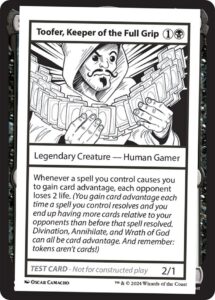
Speaking of things that don’t work the way I thought they would, the thing that immediately jumped out to me from Toofer’s reminder text is that tokens don’t count. I always thought we considered cards like Resolute Reinforcements and Desolation Twin to be card advantage because they give you two creatures for the price of one, even if one of them isn’t technically a card. That’s just the beginning of the arguments that this concept could create. Is Memoricide card advantage? Is it card advantage if your opponent only had one copy of the named card? Is using Vaan, Street Thief to cast one of your opponent’s spells card advantage? I feel like a lot of the playtest cards’ mechanics are there to test people’s reactions, but this particular phrase needs a whole lot more thinking before it can even be on the fringe of mainline cards. And it needs to include Resolute Reinforcements.
It took me an embarrassingly long time to realize that Toofer’s name comes from the phrase “two-for-one”, as in the most basic type of card advantage. Much as I generally like the playtest cards’ sense of humor overall, this particular instance doesn’t really work for me. It’s not quite enough cleverness and a little too much bringing game store slang through the fourth wall. It’s the same problem as using “mill” as the name of a keyword action. Still, if it makes people think about the way some players get sucked into a vortex of caring about card advantage ahead of fun – much less themes, aesthetics, flavor, or lore – and some seem to have a fascination with drawing cards that borders on paraphilia, maybe it’s worth it.
Overall, I feel that black’s crop of playtest cards didn’t have quite as much innovation as white or blue, nor as many plausible futures. But red is next, and since that’s the color of creativity, I’m going in optimistic!

